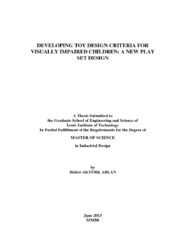Please use this identifier to cite or link to this item:
https://hdl.handle.net/11147/3604Full metadata record
| DC Field | Value | Language |
|---|---|---|
| dc.contributor.advisor | Talu, Nilüfer | - |
| dc.contributor.author | Aktürk Ablan, Hatice | - |
| dc.date.accessioned | 2014-07-22T13:51:55Z | - |
| dc.date.available | 2014-07-22T13:51:55Z | - |
| dc.date.issued | 2013 | - |
| dc.identifier.uri | http://hdl.handle.net/11147/3604 | - |
| dc.description | Thesis (Master)--Izmir Institute of Technology, Industrial Design, Izmir, 2013 | en_US |
| dc.description | Includes bibliographical references (leaves: 108-114) | en_US |
| dc.description | Text in English; Abstract: Turkish and English | en_US |
| dc.description | xi, 114 leaves | en_US |
| dc.description | Full text release delayed at author's request until 2015.08.02 | en_US |
| dc.description.abstract | Being visually impaired is a problem all on its own. The challenge is rendered even more compelling in the conditions of the modern world, where we live under visual hegemony and all our perceptions and means of communication are based on visuality. Visually impaired people have to compensate with their other senses to overcome this disadvantage. To be able to live self-sufficiently, their daily life must be based principally on their tactile and auditory senses. Throughout the history, there have been two vital elements that naturally support child development: "play" and "toy". Many scientific studies on children development have underlined the essential role of toys and play tools, as the objects of the activity of play. However, the play tools and toys designed for visually impaired children are inadequate. In fact, parents and teachers attempt to design handmade play tools to meet this need. The study has been constructed upon a literature review on visual impairment and visually impaired children; followed by an observation study carried out in the nursery and first grade classes in a primary school for visually impaired children. Based on literature review and observation study, the study has stated toy design criteria for visually impaired children to improve their skills. Underlining the design criteria, the study is finalized with a play set design to support them in their daily lives. Key words: Visual Impairment, Visually Impaired Children, Play, Play Tools, Toy, Toy Design. | en_US |
| dc.language.iso | en | en_US |
| dc.publisher | Izmir Institute of Technology | en_US |
| dc.rights | info:eu-repo/semantics/openAccess | en_US |
| dc.subject.lcsh | Children with visual disabilities | en |
| dc.subject.lcsh | Toys--Design and construction | en |
| dc.title | Developing Toy Design Criteria for Visually Impaired Children: a New Play Set Design | en_US |
| dc.type | Master Thesis | en_US |
| dc.authorid | 0000-0002-8562-4861 | - |
| dc.institutionauthor | Aktürk Ablan, Hatice | - |
| dc.department | Thesis (Master)--İzmir Institute of Technology, Industrial Design | en_US |
| dc.relation.publicationcategory | Tez | en_US |
| dc.identifier.wosquality | N/A | - |
| dc.identifier.scopusquality | N/A | - |
| item.openairecristype | http://purl.org/coar/resource_type/c_18cf | - |
| item.languageiso639-1 | en | - |
| item.openairetype | Master Thesis | - |
| item.grantfulltext | open | - |
| item.fulltext | With Fulltext | - |
| item.cerifentitytype | Publications | - |
| Appears in Collections: | Master Degree / Yüksek Lisans Tezleri | |
Files in This Item:
| File | Description | Size | Format | |
|---|---|---|---|---|
| 10011472.pdf | MasterThesis | 5.39 MB | Adobe PDF |  View/Open |
CORE Recommender
Page view(s)
568
checked on Mar 31, 2025
Download(s)
702
checked on Mar 31, 2025
Google ScholarTM
Check
Items in GCRIS Repository are protected by copyright, with all rights reserved, unless otherwise indicated.